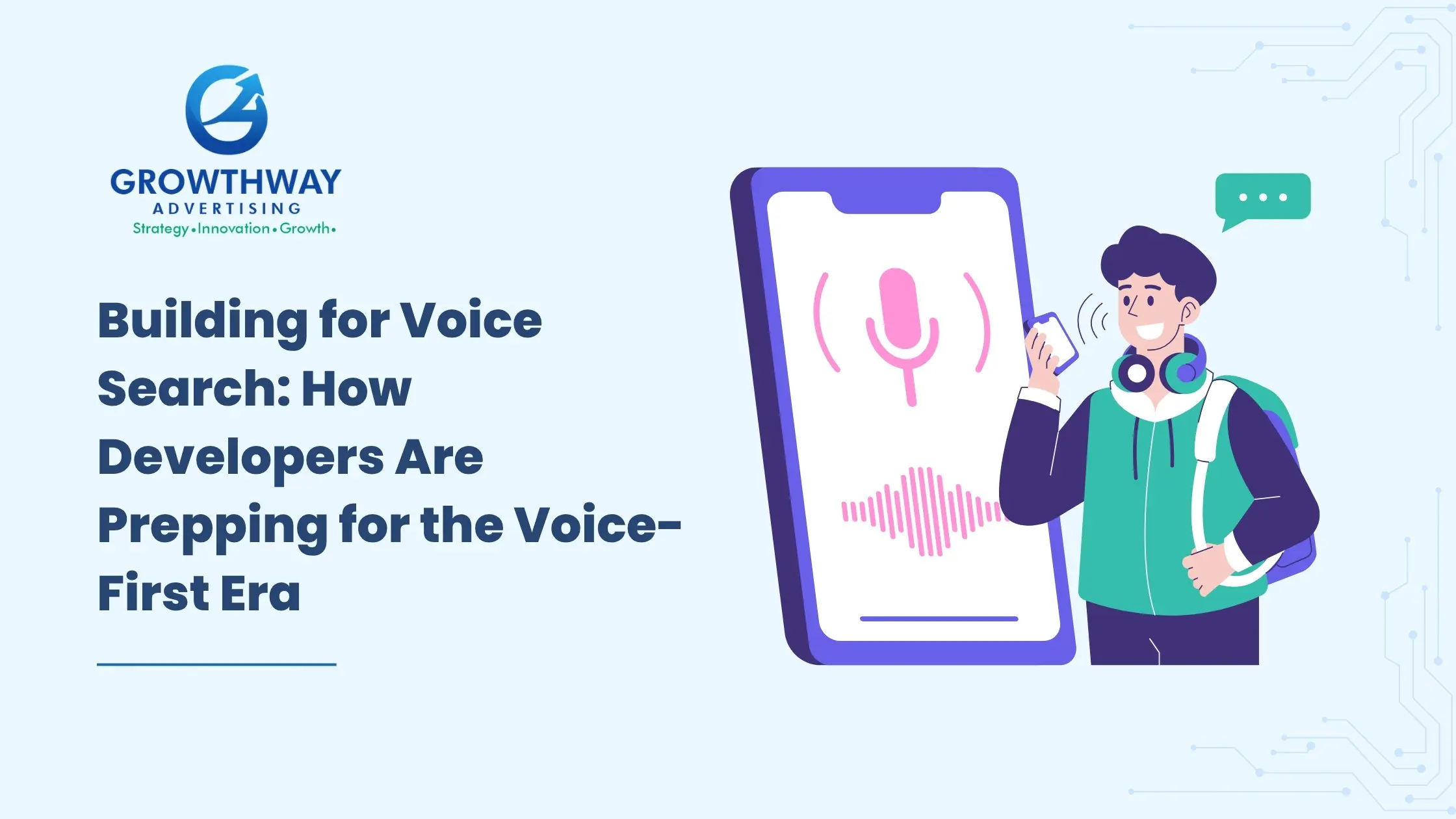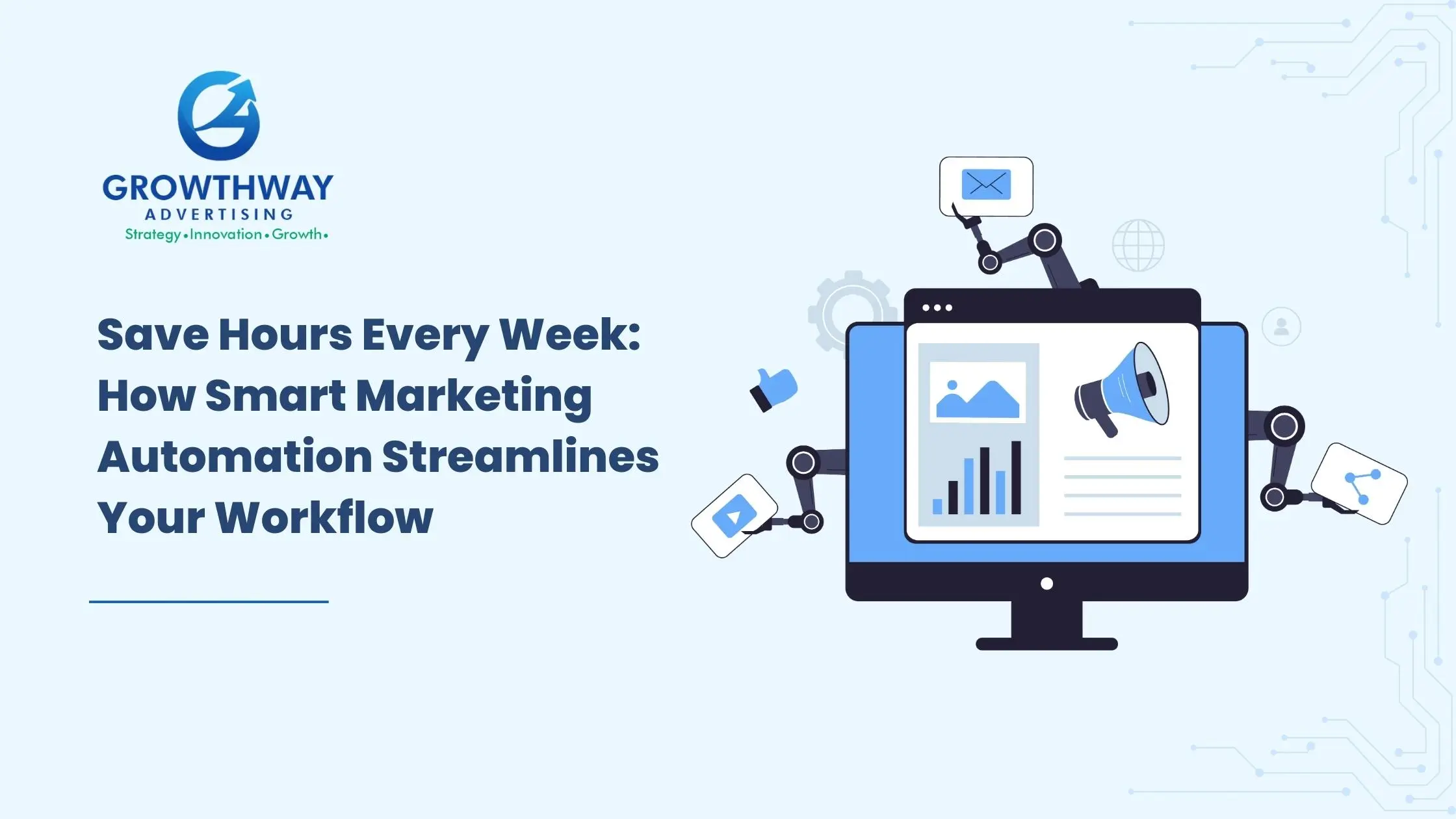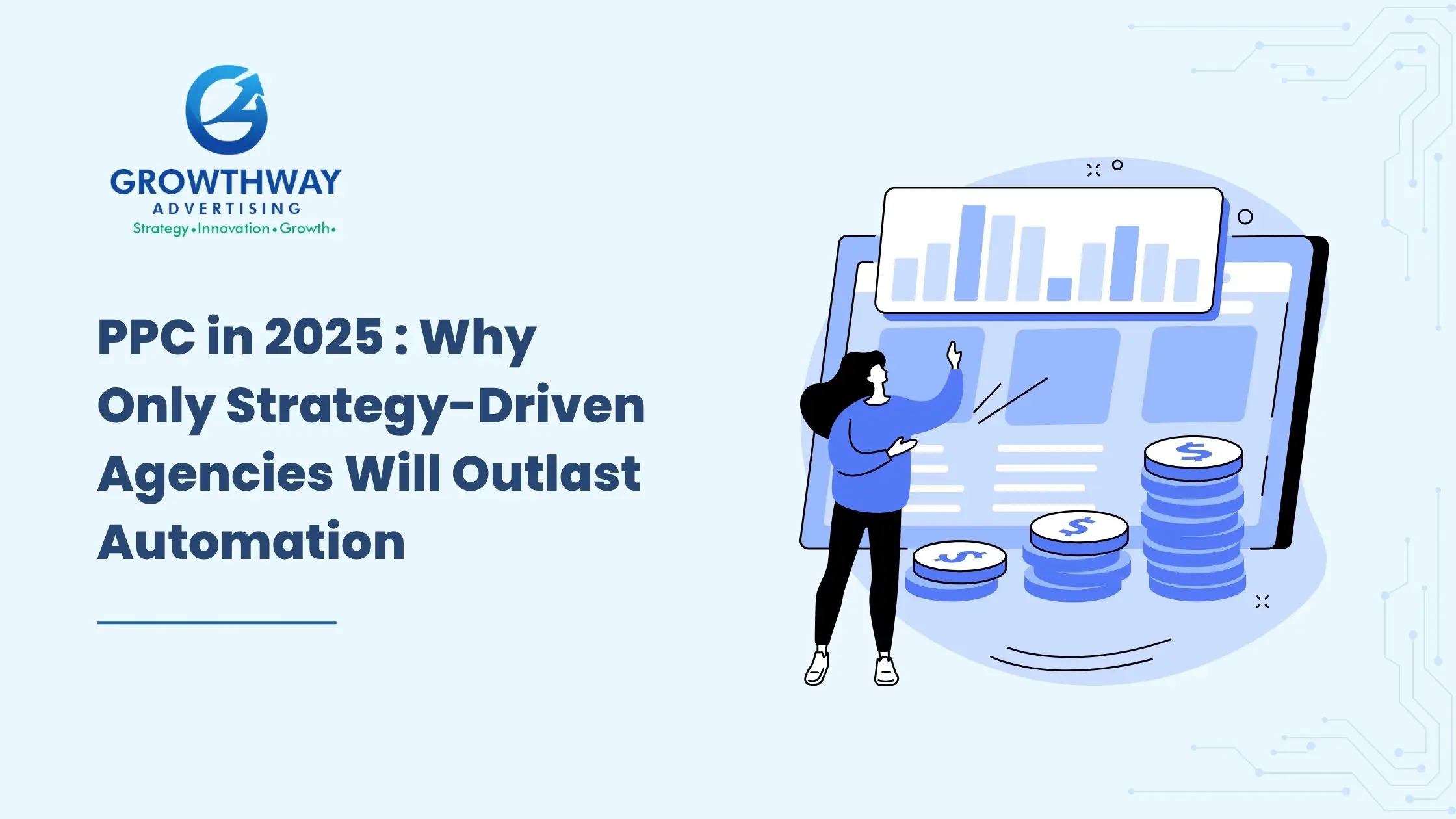The rise of voice assistants and conversational interfaces isn’t a passing trend, it’s a full-scale shift in how people interact with technology. From smart speakers to mobile voice search and car infotainment systems, the world is moving toward hands-free, screen-optional experiences. For developers, this means rethinking how websites, apps, and systems are built. The question isn’t if the voice-first era will take over, it’s how fast you’ll adapt.
Here’s how developers are preparing, what challenges they’re solving, and what it really takes to build for voice search in 2025 and beyond.
Understanding the Voice-First Shift
When users say, “Hey Siri, find a nearby Italian restaurant” or “Alexa, book a cleaning service,” they’re not typing keywords anymore, they’re having conversations. This is the essence of voice-first development: creating digital experiences designed to respond naturally to conversational search queries, not just typed phrases.
The traditional model of search, built around exact keywords, is evolving. Voice queries are longer, more natural, and often framed as questions. Developers are now focusing on context intent, semantics, and conversational flow rather than rigid keyword matching.
That’s why every web development agency needs to approach projects differently. Instead of designing just for clicks and visuals, they’re designing for how users speak and listen.
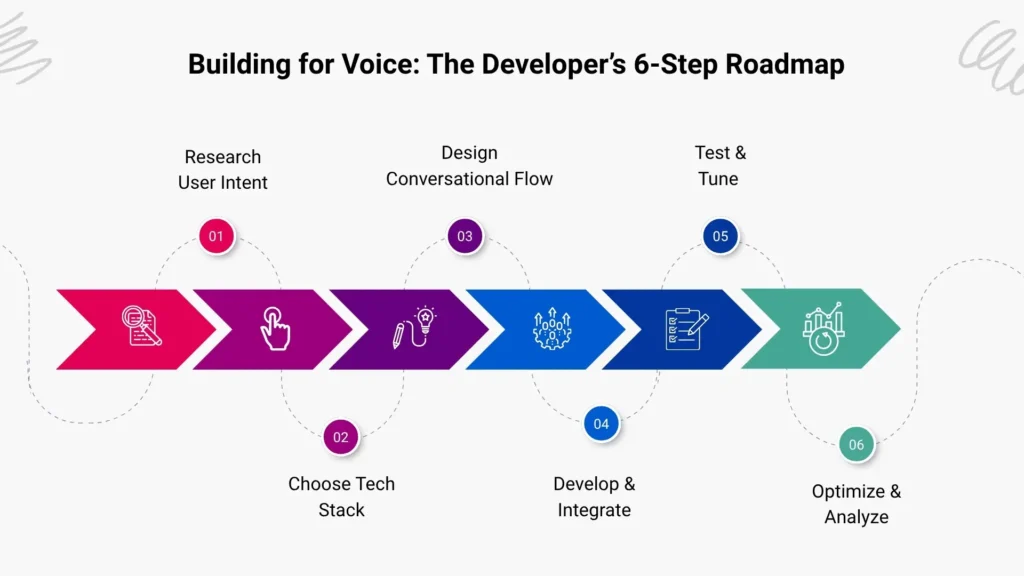
From Websites to Voice Interfaces
Developers used to think primarily in terms of screens layout, navigation, and visual hierarchy. In a voice-first world, voice user interface (VUI) replaces these elements with spoken interactions.
VUI design demands new thinking:
- How do you structure a conversation?
- What happens when a user asks something unexpected?
- How do you make sure your app or site “sounds” human, not robotic?
This is where web development services are evolving fast. Developers are building conversational apps that integrate natural language understanding (NLU) and speech recognition. Frameworks and APIs like Google Dialogflow, Alexa Skills Kit, and Speechly are part of a developer’s new toolkit.
But it’s not only about creating new voice apps. It’s also about enabling voice-first web design making existing sites voice-accessible through semantic HTML, structured data, and voice-optimized content.
Structuring for Voice Search Optimization
The foundation of any voice search SEO strategy starts in code. Developers play a key role in ensuring that a site’s structure helps search engines understand and deliver relevant voice responses.
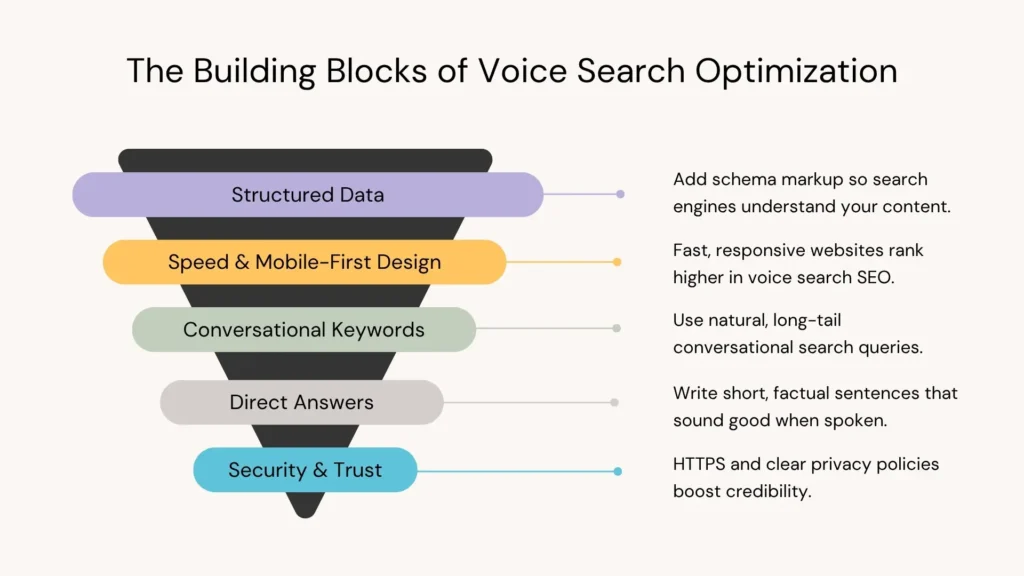
Here’s what that means in practice:
- Use schema markup to help assistants like Siri or Google interpret page intent.
- Optimize load times voice search depends on quick answers.
- Build conversational content models so that voice assistants can extract precise answers.
- Adopt HTTPS and structured data trust and clarity matter for voice ranking.
For developers offering website development services, this means collaborating closely with content teams. Code and content must align for voice recognition systems to parse and prioritize responses correctly.
A smart web development company now sees SEO and development as one process not two separate silos.
Building Conversational Apps and Experiences
The next evolution of web development is conversational. Users expect apps that respond, not just react. This is driving a surge in conversational apps, where voice and chat coexist seamlessly.
Developers are focusing on:
- Context management: remembering previous interactions and using them to shape future responses.
- Error recovery: designing natural fallback responses when a system doesn’t understand a query.
- Multimodal interaction: combining voice with visuals voice commands that trigger screen changes or data updates.
For instance, in WordPress web development, developers are integrating plugins and APIs that enable voice-based navigation, content search, or accessibility features. It’s not futuristic, it’s what users already expect.
Engineering for Speed and Accuracy
Voice applications live or die on latency. A 300ms delay feels natural in text, but in voice, it feels awkward. Developers are optimizing voice architectures to achieve sub-200ms response times using edge computing and lightweight NLU models.
To support real-time interaction:
- Voice data must be processed locally whenever possible.
- APIs should be asynchronous, not sequential.
- Response caching is crucial to minimize round trips.
These engineering choices define how fast and natural a voice-first development experience feels.
Security, Privacy, and Data Ethics
Every voice query contains personal context, tone, location, even emotion. That’s valuable data, but also sensitive. Developers must design for privacy-first voice systems, ensuring voice data isn’t stored or shared unnecessarily.
Key practices include:
- Encrypting voice transcripts in transit and at rest.
- Obfuscating identifiable speech data before analytics processing.
- Following compliance frameworks like GDPR and CCPA.
Voice-first privacy isn’t optional, it’s a brand trust issue. Any web development services provider that handles user interaction must prioritize secure voice architecture as part of their offering.
Accessibility and Inclusivity in Voice Interfaces
Voice technology has opened digital access to millions of users who previously struggled with traditional input methods. Developers are leaning into this inclusive power.
By designing with voice user interface principles, they can improve accessibility for people with visual or motor impairments. But inclusivity also means accounting for language diversity, accents, and cultural nuances.
Developers are now testing across dialects, training datasets on local speech patterns, and using feedback loops to improve understanding accuracy. This is where ethics meets engineering and where thoughtful design makes a measurable difference.
Testing, QA, and Analytics for Voice
Voice experiences need a new kind of testing. Unlike visual UIs, voice apps can’t be “clicked through.” Developers must rely on simulated speech, natural conversation logs, and acoustic testing environments.
The best practice? Treat conversations like code.
- Use synthetic voice traffic for regression testing.
- Run performance analytics on task completion rates, not page views.
- Track metrics like fallback rate, interruption frequency, and satisfaction score.
This type of analytics forms the backbone of voice search optimization not just ranking higher, but delivering better human-like interactions.
Integrating Voice into Modern Web Development Workflows
A web development agency today isn’t only building pages, it’s building experiences across interfaces. Integrating voice features into traditional stacks like React, Angular, or WordPress means thinking modularly.
Developers are using voice SDKs and APIs as microservices. That means voice can be added to any product whether it’s a customer service portal, e-commerce site, or learning platform without rewriting the entire system.
In WordPress web development, for instance, developers are embedding voice input for search bars, content read-aloud features, or voice-guided navigation using open-source libraries. These integrations make the web not just accessible, but conversational.
Preparing for the Next Phase of Voice Evolution
Developers aren’t just coding for commands, they’re building systems that can understand intent, context, and even emotion. The voice-first landscape is expanding into every vertical: healthcare, finance, retail, automotive, and education.
To stay relevant, teams are focusing on three areas:
- Continuous learning: mastering NLU frameworks and AI-powered APIs.
- Cross-platform fluency: ensuring experiences are consistent across Alexa, Siri, Google Assistant, and custom enterprise systems.
- Human-centered design: keeping empathy at the core of every interaction.
This shift is also shaping the offerings of every website development company that wants to stay ahead. Clients aren’t just asking for websites anymore; they’re asking for digital assistants, smart chatbots, and AI-ready web systems.
The Developer Mindset in the Voice-First Era
The developers shaping this future aren’t waiting for perfect tools. They’re experimenting, building, and refining. They’re designing systems that think in terms of conversations instead of clicks.
What this really means is that web development services are evolving into “experience engineering.” The same principles that once defined good UX clarity, speed, simplicity now extend into spoken interactions.
Developers who master voice search SEO, voice-first web design, and conversational apps aren’t just keeping up with a trend. They’re defining the next digital standard.
FAQ’s
Voice-first development is an approach where apps and websites are designed primarily for voice interaction rather than screen-based navigation. It focuses on how users speak to systems using voice assistants or conversational interfaces.
Voice search optimization ensures that websites and apps are discoverable through voice assistants like Siri, Alexa, and Google Assistant. It helps developers structure data, improve site speed, and create conversational content that matches how people actually talk.
Conversational apps use natural language processing to enable users to interact through voice or text as if they were speaking to a human. They improve engagement, reduce friction, and make apps more intuitive and accessible.
Voice-first web design focuses on conversation structure, contextual understanding, minimal visual clutter, and fast responses. It ensures the website delivers a smooth, natural dialogue rather than just static content.
Voice search SEO prioritizes natural language, long-tail phrases, and direct answers to questions. Instead of short keywords, it focuses on conversational search queries like “What’s the best web development agency near me?” or “How do I add voice search to my site?”

